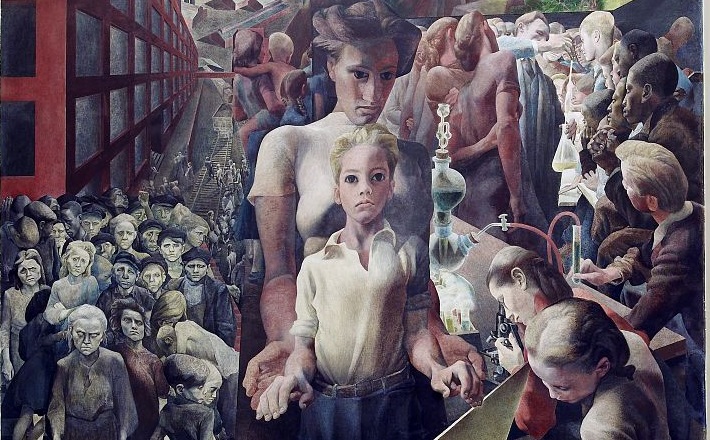Commentary on Isaiah 11:1-10
As with all scripture, this oft-cited prophesy of messianic expectations has been used to paint a picture for Christ’s reign at times detached from the message of the text itself.
Let us try to read with fresh eyes to see as Isaiah sees (see last week’s commentary for more on how Isaiah sees).
Go back to begin
Biblical scholars agree that the “choral speech” that is Isaiah 11 begins with YHWH’s action of “lopping off” branches in the previous chapter1:
Look, the Sovereign, the Lord of hosts,
will lop the boughs with terrifying power;
the tallest trees will be cut down,
and the lofty will be brought low.
He will hack down the thickets of the forest with an ax,
and Lebanon with its majestic trees will fall (Isaiah 10:33-34).
Again, the new world order in Isaiah begins in destruction—the destruction of forces that do not make for justice and righteousness. In this particular situation, the branches refer to forces in northern Palestine being lopped off to reduce the power of the Assyrian Empire.
Stripping away our messianic expectations
Isaiah 11:1-5 describe the one who is to come after those forces are defeated to restore Israel. Isaiah is painting the picture of a positive reign, harkening back to King David, in the midst of a disappointing reign (the reign of King Ahaz).
Isaiah 11: 3-5 describe how this person governs rightly by 1) fearing YHWH; 2) not making decisions hastily at the surface level of hearsay; and 3) making decisions based on what is just for those who suffer in the land. When the governor makes decisions based on these rules, the wicked will feel as though they have been struck by the governor’s decrees, their way of life put to death (verse 4). Clothed in righteousness and faithfulness, the anointed governor will obey directions from the Spirit and have the strength to carry out the plans to completion.
Nowhere in this passage is there language of “King.” Nor is there an image of the anointed ruling with some sort of military might (the decrees from the ruler’s mouth strike the land and slay the wicked, not a military fleet). Read again how this anointed and hoped for one reigns and for whom they make decisions. The tension between this image of God’s anointed ruler and the image contemporary preachers paint of God’s anointed ruler do not rest easy beside each other. Overhearing Isaiah causes us to strip away accumulated layers of false messianic expectations. This passage also may challenge caricatures of Jesus as Messiah erroneously constructed to support a timid Jesus who doesn’t get too political for our comfort zone.
Isaiah 11:6-10 vividly describe the impact of reinstating a ruler who is open to the Spirit of YHWH. The whole earth will be covered with knowledge of YHWH (rather than YHWH’s knowledge, which I think humans are incapable of claiming without slipping into grandiose harmful godlike fantasies). And once creation knows/remembers/receives the counsel of YHWH, there is unheard of security in the natural world, resulting in the humorous images Isaiah paints for us: babies handling snakes and bears passing up a steak dinner. The hyperbole is hyperbole because such a scene is too impossible to implement by our human might alone.
Sermon image
The United States Department of Justice established a permanent home in 1935. From 1938-1941, 61 murals funded by the Public Works Arts Project were completed in the Art Deco building. Each mural revealed artistic vision of what justice in this nation should/could look like.
One of the most striking images emerged from the mind of Symeon Shimin, a Russian born immigrant to Brooklyn, New York. In 1938, Shimin was hired to paint a mural, and “Contemporary Justice and The Child” was born.2 It took four years to complete the mural, which can still be seen on the third floor of the Department of Justice building in Washington D.C. today.3
Through the eyes of an immigrant, we move from what is to what could be in the United States, left to right. On the left-hand side, Shimin depicts the brokenness of the nation. Dooming factories billowing smoke into the sky. The haunting eye contact from a mass of poor people in shades of gray. A pair of men asleep, contorted, in the shadows. All of these situations, and the systems that are designed to support them, are in the eyes of the artists where justice is absent.
On the right-hand side are images of the activities that lead to the construction of a just land. Note the brown hands holding the tools for reconstruction in the America of the late 1930s, decades before African Americans even had the right to vote. And see women alongside men, laying blueprints out for a just land. See the scientists, male and female, white and brown, innovating a just future. And enjoy the playfulness in the top right corner in a green land with clean air.
Finally, in the center, a mother and her child.
And a child shall lead them
This week, perhaps we should let children image the story of shalom for us as we anticipate the Prince of Peace. Bring to your congregation their stories, old and new:
- Ruby Bridges, the first African American child to desegregate the all-white William Frantz Elementary School in New Orleans.
- Greta Thunberg, the 16-year-old Swedish activist who is speaking out about climate change and its impact on generations to come.
- Muzoon Almellehan, a Syrian activist and refugee working out of the United Kingdom to keep Syrian girls in school.
- Emma Gonzalez, survivor of the shooting at Stoneman Douglas High School and activist and advocate for gun control in the United States.
What children are speaking up in your context? And what is their message of peace?
And ask yourself, jaded as we are by the appearances of this world in the news and the hearsay of our situation on Twitter feeds, will you accept the counsel of the children at the center of it all so we can step into shalom at last?
Notes:
1 John D.W. Watts. “Isaiah 1-33” in World Bible Commentary, Volume 24 (Waco, TX: Word Books Publisher, 1985), 169.
2 Symeon Shimin, 1902-1984. Contemporary Justice and Child, from Art in the Christian Tradition, a project of the Vanderbilt Divinity Library, Nashville, Tennessee.


December 8, 2019